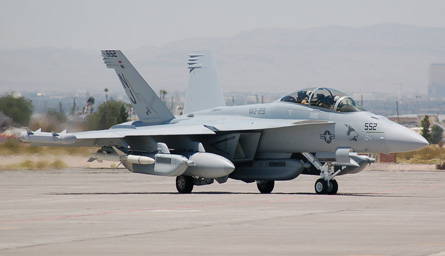Boeing delivered the first operational EA-18G Growler electronic warfare aircraft to the US Navy on 3 June, completing a five-year, $1 billion development phase and starting a year-long series of final check-out tests.
The aircraft will next join three development examples (one pictured below) for a six-month operational evaluation starting in September. A final series of flight trials at the USN's China Lake test range in California will pave the way for standing up the first operational EA-18G unit in late fiscal year 2009.
 |
|---|
© Craig Hoyle/Flight International |
"Seven years after the navy selected the EA-18G to replace the [Northrop Grumman] EA-6B Prowler, the Growler has arrived - on cost and ahead of schedule," secretary of the navy Donald Winter said during the delivery ceremony at NAS Whidbey Island, Washington.
The EA-18G leverages the airframe of the Boeing F/A-18F Super Hornet and Northrop's improved capability-III (ICAP-III) electronic warfare suite now flying on a subset of the EA-6B fleet.
Boeing executives, however, insist that several EA-18G features transform the aircraft into a next-generation jamming platform, including its use of the Super Hornet's Raytheon APG-79 active electronically scanned array radar. The ICAP-III suite also incorporates an all-new communications countermeasures set and an interference cancellation system, which allows EA-18G crews to continue communicating with other friendly aircraft even while jamming enemy radar.
But the most important leap is a new software package called the EA-18G data correlation mechanism, says Boeing programme manager Mike Gibbons. This automatically correlates streams of data generated by all of the Growler's on-board sensors, including the APG-79, ICAP-III receivers and even the Raytheon AGM-88E high-speed anti-radiation missile.
Better performance is also coming from unexpected sources, says Capt Mark Darrah, the navy's F/A-18 and EA-18 programme manager. Splitting the tail-mounted "American football"-shaped ALQ-218 receiver into two separate wingtip pods for the EA-18G was considered a design risk, but has improved the overall system's performance.
Although the wingtip presents a more aerodynamically harsh environment for the receiver, special materials developed for the radome have overcome hazards such as hail-strike, and the new location offers better signals reception, regardless of the radome issues. "We're actually seeing signals that we never saw before [with the EA-6B]," Darrah says.
The USN plans to buy a total of 85 EA-18Gs through the next decade, although only the first 52 are under contract for production over the next four years. Another three are sought by the navy in the pending supplemental budget request for FY2008.
More orders could be added depending on how the US Air Force decides to acquire an expeditionary electronic warfare fleet. USAF officials have repeatedly rejected the carrier-based EA-18G, but Boeing insists that the Growler remains in play. The US Marine Corps is also studying replacement options for its EA-6Bs, but is expected to focus on converting the Lockheed Martin F-35B Joint Strike Fighter into a jamming platform.
Source: Flight International
















